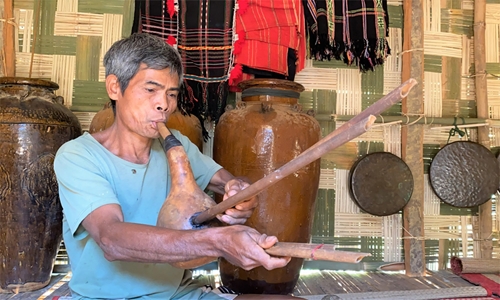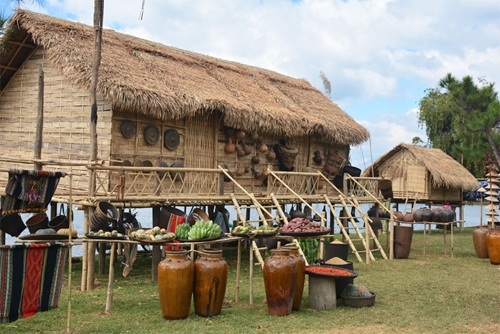Visiting the longhouse this spring
We were driving down to Cat Tien when the spring colors were blooming everywhere. Spring in the plateau always brings a liberal beauty with bright yellow sunshine, coffee and cashew flowers dying white mountains and hills. In the distance, the Dong Nai River glowed red, carrying basaltic alluvial water down to the sea. On the river banks, thousand-year-old temples in Cat Tien sanctuary still quietly reflected the mysterious light of a dead civilization.
    |
 |
|
Veteran Dieu K’Boi plays a musical instrument in his “nha dai” in Bu Gia Ra village, Dong Nai Thuong commune, Cat Tien district, Lam Dong province. |
In a house with smell of new wood and “can” liquor which is drunk out of a jar through pipes in Bu Gia Ra village, Dong Nai Thuong commune, Cat Tien district, Lam Dong province, veteran Dieu K'Boi from the Ma ethnic group played gongs to greet us - his guests - and then passionately told us about the legend of the ancient land of Cat Tien, the origin of the Ma ethnic group and the “nha dai” that he tried to restore in early 2021.
“This house is just more than six arms’ length but it took me more than two months to complete it. With the ‘nha dai,’ spring and Tet (lunar New Year) holiday are more joyful; the sound of the gongs goes farther; buffalo meat is more delicious to eat; it is easier to get drunk while drinking “can” liquor; and all villagers feel happy,” proudly said veteran Dieu K'Boi.
Saying goodbye to veteran Dieu K’Boi, we drove up to Loc Bac, a mountainous commune in Bao Lam district, Lam Dong province, where the only longhouse in the Southern Central Highlands still lives its true life for decades. The owner of this longhouse in Bo Dang village, Loc Bac commune is Mrs. Ka Dit, aged nearly 70. She cannot remember when the house was built but the fact that she saw it when she got married.
Some years ago, her family received financial assistance from local cultural sector to upgrade the house to make it longer and more beautiful. Mrs. Ka Dit’s 20m-long house consists of a paddy store outside and spaces for jars, gongs, back baskets, dried gourds, and more inside. These common items are valuable assets of the Ma ethnic group.
As time passes by, these items are smoky, glowing black, creating a feeling of the past. In the midst of a new rural area full of coffee, concrete roads and new-style houses, the “nha dai” of Mrs. Ka Dit's family is like a rest in a vibrant symphony, and part of the memory that reminisces the old Central Highlands filled with “epic colors.”
Restoring longhouses
Like other ethnic minorities in the Central Highlands, the Ma ethnic group in Lam Dong used to live in the “nha dai.” The houses are made from wooden frame, roofed with rattan leaves, and their walls are made of bambusa balcooa or bamboo.
    |
 |
|
The beauty of a “nha dai” and a rice store of the Ma ethnic group |
For people living in the mountains, their houses’ floor is lower than the ground, meanwhile, for people living next to the Da Don stream (a section of the Da Dang River in the upstream of the Dong Nai River) the floor is higher. In the house, details such as columns, trusses, beams, are strongly joined by tenons, mortice, and forest rattan.
Many generations live together in a “nha dai.” Whenever a newly-wed couple move in, the house is expanded with a room and added with a kitchen.
Over the years, these houses have been lengthened, looking like a giant brocade lying across the green mountains and getting as long as the sound of a gong.
According to Dinh Thi Nga, who have for years studied and collected artifacts bearing the culture of the Central Highlands and is living in Da Lat city, Lam Dong province, the “nha dai” is a typical cultural form, reflecting people’s reaction to nature, family morphology and unique folk knowledge of ethnic minority groups in the Central Highlands.
For local people, the longhouse is not only a place to reside, but also a sacred space, a place to keep the fire, “keep” the gods, nurture ancient songs, keep the gongs and “xoang” dances (typical dances in groups of ethnic minorities) handed down from generation to generation. It is only in the “nha dai” the life and ritual practices of the Ma ethnic people in particular and other ethnic groups in the Central Highlands in general take place in a methodical and complete manner. The “nha dai” together with green forests, waterfalls, forest fire, local people’s life, agricultural rituals have created a matriarchal tradition, polytheistic beliefs, gong culture space and a special “civilization of herbs.”
Though playing an important part of the culture of the Central Highlands, the “nha dai” has been absent from their homeland for a long period of time. The modes of production, and the family organization forms of ethnic minorities have changed a lot. Forests are shrinking, resulting in the increasing scarcity in the source of materials for longhouse building. In addition, the new lifestyle with modern facilities has made part of the young people no longer eager for the house.
However, with many people like veteran Dieu K’Boi, and Mrs. Ka Dit and those with deep love for the Central Highlands culture like Ms. Dinh Thi Nga, the “nha dai” are always the source of nostalgia, and bear an eternal value. That is the reason why they are determined to preserve and restore the house.
At the eighth Da Lat Flower Festival in 2019, Ms. Dinh Thi Nga used her own money to hire Ma ethnic artisans from Buon Go village, Cat Tien townlet, Cat Tien district to Da Lat to erect a “nha dai” by Xuan Huong Lake. During the nearly week-long festival, 36 artisans performed a series of Ma cultural quintessence, such as new rice celebration, friendship ceremony, “can” liquor brewing, brocade weaving, pottery making, and more. The activities performed next to the “nha dai,” in the rice warehouse, by stoves and under sacred “cay neu” (lunar New Year pole) were the highlights of the festival, drawing a lot of visitors.
Coming to the Southern Central Highlands this spring, apart from the “nha dai” owned by veteran Dieu K’Boi and Mrs. Ka Dit’s family, visitors will have an opportunity to see many others newly-built in tourist sites in Da Lat city, in the space of Cat Tien Sanctuary, in Village 2, Loc Tan commune, Bao Lam district.
Seeming to have fallen into oblivion for a long period of time, the “nha dai” in the Southern Central Highlands have awakened, making the cultural flow of the Central Highlands to continue and develop on the reddish basaltic soils of plateau, bringing chances for visitors to learn more about and love the “dreamland” of the Central Highlands.
Translated by Mai Huong